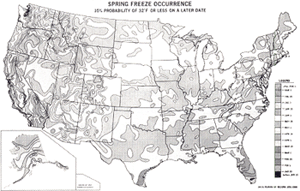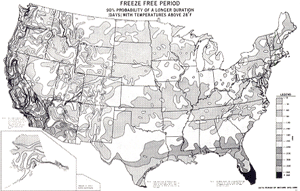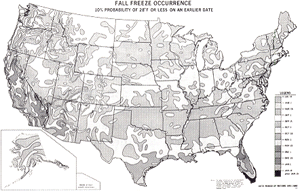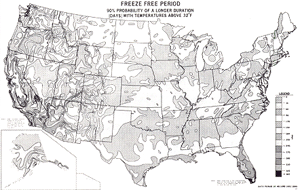Hot & Cold Weather Masonry Construction
Weather Services
General. The design, planning, and execution of all-weather masonry construction requires several types of weather service data. These data fall into two general categories: climatology, which may be defined as the historic record of the average and extremes of temperature phenomena; and meteorology, which may be defined as the current state of the atmospheric conditions and their short-term projected movements and consequences.
In the early planning stages of all-weather masonry construction projects, the average climatologic data is of particular importance. For example, average daytime and nighttime temperatures, average wind velocity for the expected period of construction, as well as the expected extremes for these periods, are factors that need to be considered. From such data, judgments can be made as to the amount and type of protection, if any, that may be necessary, approximate length of time each protection requirement will be in effect, and the approximate date when construction requirements must be changed. Planning and cost estimates can then be adjusted accordingly.
Sources of Information. There are several sources of climatological data and information available. The major source for this information is the National Climatic Data Center (NCDC), an agency of the U. S. Department of Commerce.
The National Oceanic And Atmospheric Administration (NOAA) Data Centers (of which NCDC is the largest) provide long-term preservation and management of, and ready accessibility to, environmental data. The combined archive includes records taken before Ben Franklin's weather observations and continues with the latest real-time satellite imagery. The centers are part of the National Environmental Satellite and Information Service (NESDIS).
Climatological Information: Data tables of meteorological elements are available that outline the climatic conditions at major weather observation stations in all 50 states. These tables contain the following information:
Observed Data
Temperature - Highest of Record
Temperature - Lowest of Record
Mean Number of Days Minimum Temperature 32°F or Less
Mean Number of Days with Precipitation 0.01 inch or More
Snowfall (Including Ice Pellets and Sleet) Average Total in Inches
Wind - Average Speed (mph)
Wind - Maximum Speed (mph)
Sunshine - Average (Average Percent of Possible)
Cloudiness - Mean Number of Days (Clear, Partly Cloudy, Cloudy)
Average Relative Humidity - Morning, Afternoon
Climatological Normals
Normal Daily Maximum Temperature
Normal Daily Minimum Temperature
Normal Daily Mean Temperature
Normal Heating Degree Days
Normal Cooling Degree Days
Normal Precipitation, Inches
On line ordering of these tables is available at: http://www.ncdc.noaa.gov/oa/ncdc.html
Much of the information available through NCDC may also be accessed through publications, on-line services, and on CD-ROM. A complete listing of NCDC products and services may be obtained by contacting:
U. S. Department of Commerce
National Oceanic and Atmospheric Administration National Environmental Satellite, Data and Information Service
National Climatic Data Center Federal Plaza
151 Patton Avenue
Asheville, NC 28801-5001
Telephone: (704) 271-4800
Facsimile: (704) 271-4876
NCDC also maintains an Internet website which may be accessed at: http://www.ncdc.noaa.gov/
Meteorological Information. The U. S. Weather Bureau operates or gathers data from thousands of stations all over the world, including weather photo satellites. It is on these basic data that the "forecasting" of weather is based. The Weather Bureau is, however, responsible only for specific types of short range information and forecasting. Among these are weather phenomena, which may result in disaster, i.e., loss of life or property from wind, rain, flooding, tidal disturbances, etc. Their principal services are for the use of farmers, aviation and marine interests, and the public. The public forecast usually consists of:
- Present temperature
- Present sky condition (clear, cloudy, etc.)
- Present wind velocity and direction
- Present relative humidity
- General prediction for high daytime temperature
- General prediction for next-day sky condition
- General prediction for low overnight temperature
- General prediction of next-day precipitation possibility
These data may be readily obtained in abbreviated form through daily newspapers, local radio and television broadcasts, and the cable television Weather Channel. This information, although general and for an entire metropolitan area, may be sufficient for some minor decisions, but will not suffice for critical construction decisions.
Meteorological Consultants. The basic source data and information collected by the Weather Bureau is also available to private meteorological consultants who provide specialized services. These private consultants can take the raw data and make specific forecasts for the project site area. The forecast will be for the pertinent information needed and in a language that can be interpreted by the contractor.
The American Meteorological Society has established a program for the certification of consulting meteorologists. The principal purpose of the program is to enable users of meteorological services to select consultants with greater confidence in the quality and reliability of the products and services they provide. Some of the areas of specialization include:
Applied Meteorology
Regulatory Permits and Applications Consulting Services
Forecasting and Weather Prediction Expert Testimony
Climatology
For a complete list of Certified Consulting Meteorologists and services, contact the American Meteorological Society, 45 Beacon Street, Boston, MA 02108; Phone: (617) 227-2425




Maps courtesy of National Climatic Data Center (NCDC)
Summary. All parties involved with masonry construction should be cognizant of the construction schedule, the probabilities of cold or hot weather masonry construction being necessary, and the availability of weather data and services. If more specific interpretation is required, consideration should be given toward obtaining the services of a professional meteorologist.
Return to Hot & Cold Weather Masonry Construction